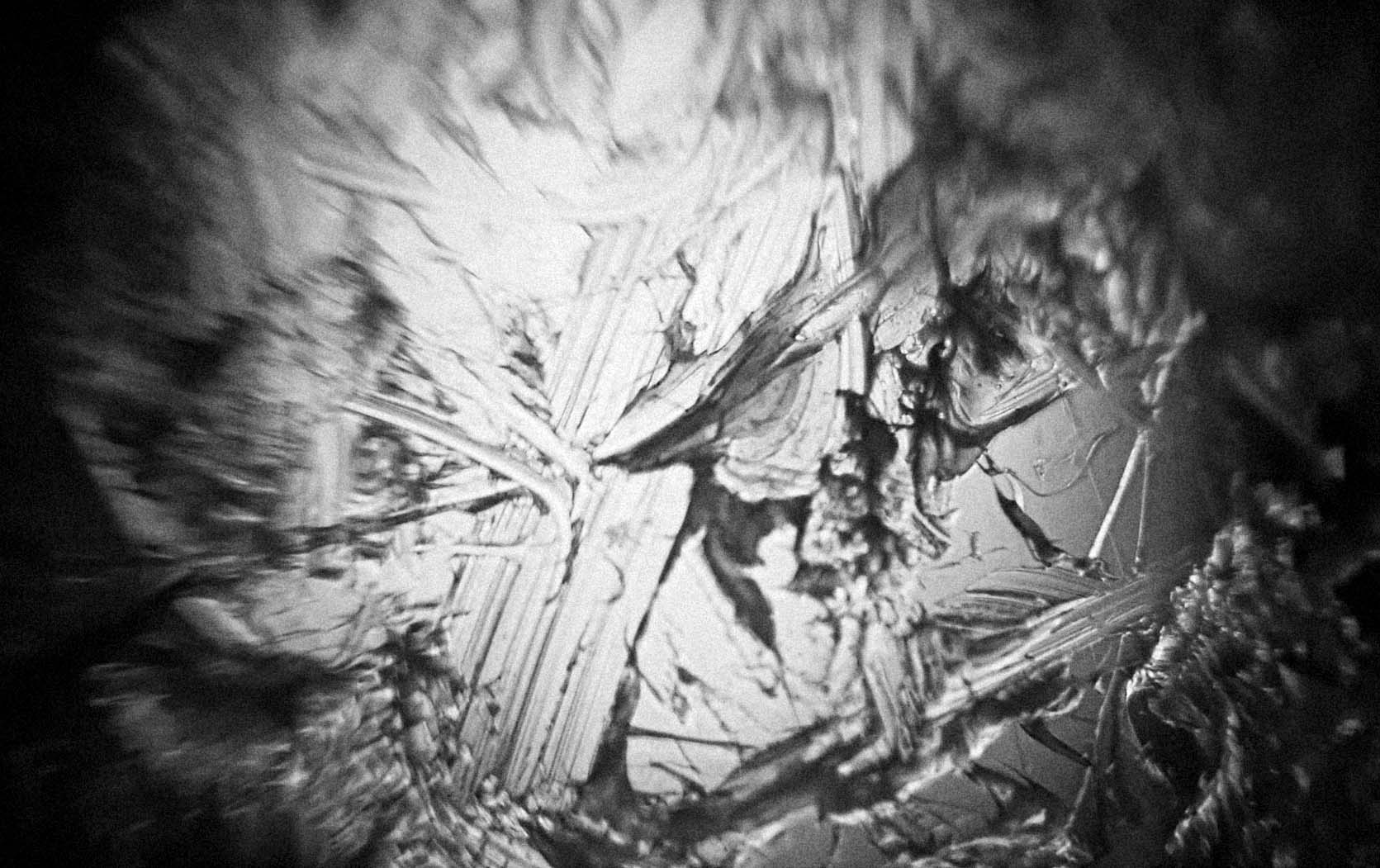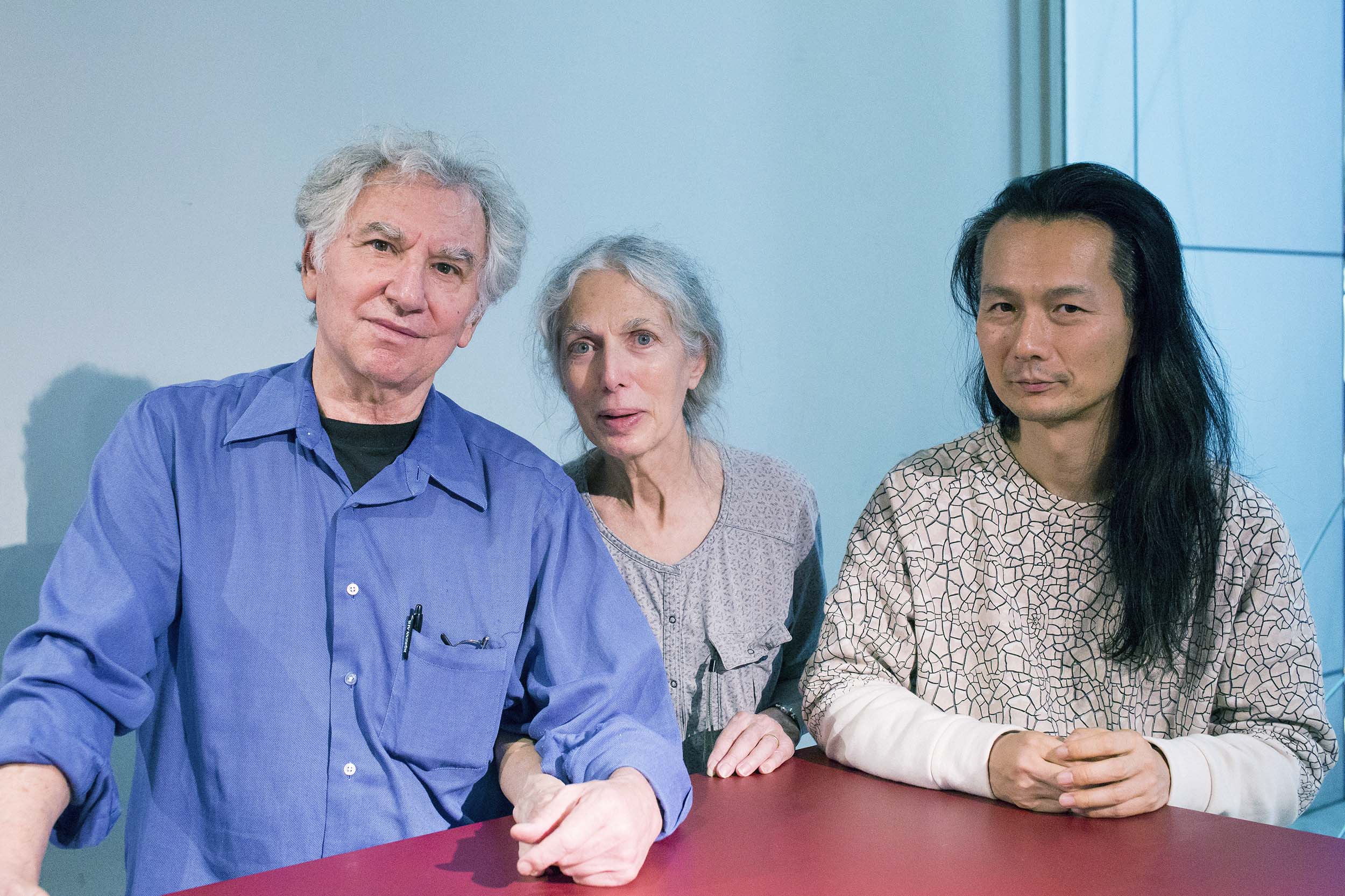In the Depth of Illusion for Ken Jacobs’ Nervous Magic Lantern
Text by Aki Onda

Listen to album HERE
This album was recorded as a soundtrack for Ken Jacobs' Nervous Magic Lantern at Spiral Hall, organized by Sound Live Tokyo, on November 3, 2015. It was probably one of our best performances in our over-a-decade-long collaboration. But even before we started working together, we shared a bit of history. Let me start from the beginning.
As I started my life in New York in the early aughts, Ken Jacobs, an essential figure of avant-garde cinema, quickly became one of my favorite filmmakers. I got acquainted with Jonas Mekas and became a frequent visitor at Anthology Film Archive. In turn, this led me to Ken's 1963 film Blond Cobra, which captures Jack Smith's enigmatic queer-trashy performance/rant left a lasting impression on me. I attended Ken’s other screenings and learned his work through Jonas' Movie Journal: The Rise of the New American Cinema,1959-1971 and the back numbers of the Film Culturemagazine left in the basement of Anthology. In 2004, I was invited to perform my Cassette Memories project in Argos Festival, Brussels where Ken’s retrospective was also a part of the program. Watching his seven-hour magnum opus, Star Spangled to Death, blew my mind. Collated over 46 years, found footage is collaged with Ken's shots of Jack Smith and Jerry Sims' hilarious yet subversive guerrilla actions. It's about American history, especially its ill-fated politics, and concurrently about Ken's individual history. It was in the midst of the Bush era, and as we witnessed the 'war on terror' and were sucked into the gloomy political climate after the September 11 attacks, the film resonated strongly with me (Ken has been a vocal critic of the GOP's anti-democratic and authoritarian agendas for decades). I also attended a couple of his Nervous Magic Lantern performances — the three-dimensional images created with a handmade apparatus, which he calls “cinema without film or video.” For a 2005 performance at MoMA, John Zorn composed the soundtrack, which was played by Ikue Mori, as musical accompaniment. After the show, John and I happened to share the same train car heading downtown. When we got to talking, he mentioned he had just escaped Ken’s furor as he’d been set off by some element of the soundtrack. I wondered what sort of person could get angry at John, the head honcho of the Downtown music scene, and then recalled my friends’ warnings about Ken’s headstrong temperament and his nickname, “Nervous Ken.”
In 2007, a film curator Stoffel Debuysere suggested that Ken work with me on a Nervous Magic Lantern performance for the Argos Festival in Brussels in 2007. Ken and his wife, Flo, came to my concert at The Stone on the Lower East Side. As they liked it, I was invited to their top-floor loft on Chambers Street in TriBeCa, where they have lived and worked since 1965, to experience a private screening of his work. The loft is one large room and evokes a cave — their film equipment, books, printed ephemera, and all sorts of personal stuff stacked high in tidy piles all around the space. There is a screen hanging from the ceiling, with a small space right in front from which you can see it. Ken turned on the apparatus on the other side of the screen and the image flashed onto the screen: geometric patterns — something of a Rorschach inkblot, though with all sorts of intricate detailing — rotated as if in a whirlpool, and three-dimensional imagery pulsed with strong flicker. What was weird was that the images did not adhere to the surface of the screen. They stood out, almost floating, like holograms. Then, my eyes started catching physical shapes in the depth of the abstract patterns such as faces, hands, moiré patterns, the surface of an oil spill, and they appeared and disappeared like ghosts or doppelgängers. Hypnotic and even hallucinatory. It’s probably because the light source is much closer to the screen in the living room, compared to MoMA or any other theaters, that the visual and psychological effects were much stronger. “How does Nervous Magic Lantern work?” I asked Ken. The inventor's answer was something unexpected: "I don't know! I dreamed it and found it through experimentations then stuck to it. I'm not that technical." Well, he is an artist who creates a phantasmagoria of mystery; let the neuroscientists explain the mechanism.
The apparatus contains a spinning shutter, a light source, and lenses set in a wooden frame. He inserted his hand-painted, circular slides between the light and lenses and moved them gently with his hands. The lenses enlarged a tiny portion on the slide, while the spinning shutter gave the flicker effect. The idea, projecting and enlarging an image on a slide, draws upon the magic lantern image projector, developed in the 17th century and commonly used for entertainment purposes — a tie to cinema’s roots, a moment often turned to in Ken’s work. It's also an evolution of Ken's earlier invention: Nervous System — two 16-millimeter projectors with a rotating shutter showing identical film strips. The same as the Nervous Magic Lantern, the apparatus also creates an illusion of depth as optical effects, though there are concrete visual images as he uses found footage.
Compared to Ken's other works, which are often filled with unflinching political criticism, the imagery of Nervous Magic Lantern is patently abstract, perhaps scratching at something more fundamental: how our brain regulates our perceptions. In Jonas' Movie Journal, Ken once said, “We’re stepping towards a deeper incline, something challenging our notion of the way things are. Something impossible.” Elsewhere he stated, “Eisenstein said the power of film was to be found between shots. Peter Kubelka seeks it between film frames. I want to get between the eyes, contest the separate halves of the brain. A whole new play of appearances is possible here.” Nervous Magic Lantern offers up this sort of play in stunning hallucinations, strange visions dancing on the screen.
Going back to our collaboration, Ken, Flo, and I flew to Brussels for our first performance for the Argos Festival, hosted at Bozar. Ken's only request for my music was to play “sounds of daily life.” He explained that the project “is an escape,” and that he felt “guilty not having any messages or reflecting the real world. By using environmental sounds to surround us,” he continued, “I'd like to be rooted in the real world." As my decades-long cassette practice produced thousands of field recordings, it was definitely manageable. And, as field recordings exist in three-dimensional physical space before they’re captured, it is relatively easier re-creating a sense of space with them, compared to musical instruments. I also asked the venue to install a surround-sound speaker system in the venue as I thought it would help to give the sounds the same illusional depth Ken's projection creates.
There was a funny moment during the performance as one of the audience members, Charlemagne Palestine, stood up and started wandering around, looked into Ken's apparatus and came by my table to pick up my cassettes for closer inspection. Nobody noticed this, as Ken and I were setting up our gear behind the audience. Ken and Charlemagne once shared a studio in Lower Manhattan back in the '70s but they hadn't talked to each other for decades. Charlemagne and his wife, Aude Stoclet, took us to one of their favorite Belgian Brasserie after the show, a nice reunion.
Both Ken and I were fulfilled by our first show, and we agreed we should continue performing together. Other than in our home city, New York, we performed in Bologna, Rotterdam, and Ghent.

Ken, Flo, and me in Tokyo, 2025
Photo by Hideto Maezawa
Photo by Hideto Maezawa
As for our Tokyo trip, it was Ken and Flo’s first visit to Japan in 22 years. Ken, 82 years old by then, and Flo were aware that this would be the last time to take a long-haul flight to the Far East due to their age and that travel had been getting excruciating. Flying from New York, we stopped in Seoul to present the same performance, then headed to Tokyo. I had a feeling this could be our last, but luckily, there was more. We traveled again in 2018, this time to Los Angeles for a performance at REDCAT.
Before the Tokyo performance, Ken explained to me the selected slides he uses and the ordering he employs, so that I would better understand the flow. Some slides are black-and-white and some color. Depending on the painted image, they create completely different patterns. When Ken was young, he aspired to be a painter and studied with Hans Hofmann, a unique and prominent figure of Abstract Expressionism. Maybe this project was an extension of his earlier interest. For a given performance, Ken selects 10 slides or so. However, he might play with just one slide for the entire show or change the order—there was plenty of room to improvise. On my side, I also had a structure and the order of tapes, quite independent from Ken's visual. But I made the system easy to extend or shorten, duration-wise, in order to respond to Ken's ordering and mood. In fact, this Tokyo performance was planned to be 60 minutes but extended to 90.
There was also a shift in the sounds I played over the years of this collaboration. Around 2014, I noticed that Ken had a sizable collection of cassette field recordings he had amassed over the last several decades. Street noises in Chinatown, conversations with friends, political speech, or any sort of uncategorizable sound around him. I was fascinated and decided to use them as a springboard for composing, and it was refreshing to incorporate another person's perspective. One of the unique aspects of Nervous Magic Lantern is that the visual stays abstract while the sound is able to adopt meanings or even a narrative sense derived from the quotidian sounds. This means, the role of each medium as they’re defined in conventional films, that the visual suggests meanings and the sound amplifies them, is flipped. By using Ken’s sounds, I wanted to emphasize that point and add almost a sense of documentary to the performance. More than that, I simply loved the aural depictions of Ken and Flo’s life, and their children Azazel and Nishi, as they appear at times. Those also trigger my memories with them. Over the years, during summer time, Ken, Flo, and my wife, Makiko, made a habit of going to their favorite restaurant in Chinatown. Other times, Ken and I had morning coffee at a Puerto Rican restaurant just below their loft on Chambers Street. Life and art are inseparable, breaking into one another incessantly. Ken is an artist who always envisioned the impossible. I wanted to see if it's possible to present that vision as something universal, something whole, something running through everyone’s life. A soundtrack for life in the depth of illusion. That is perhaps what this album is.
Lastly, I dedicate this album to Flo Jacobs who passed away just recently. She is deeply involved in Ken's creative process; as he says: “This is a mom-and-pop business.” From the first day of working together, she was always there with us and took care of all practical matters. Ken is a dreamer and thinks and works intuitively. But Flo — an exceptionally beautiful woman in and out — is rooted in the real world. Not just a pragmatist, however, Flo advises Ken on artistic decisions. Ken always asks to hear her thoughts, as I did as well. As film critic and their decades-long friend Amy Taubin once described it, "Florence Jacobs is nothing less than a producer of Ken Jacobs' cinema." What a perfect couple, and it was an extremely joyous journey with them!